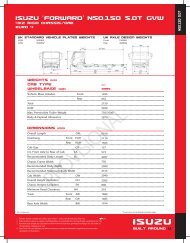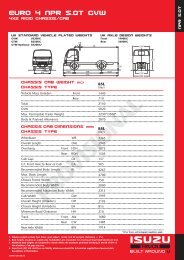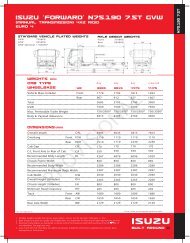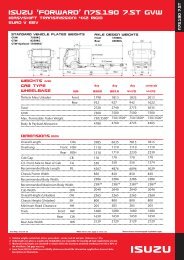ISUZU LAID BARE - Isuzu Trucks
ISUZU LAID BARE - Isuzu Trucks
ISUZU LAID BARE - Isuzu Trucks
Create successful ePaper yourself
Turn your PDF publications into a flip-book with our unique Google optimized e-Paper software.
at the heart of the roaD traNSPort iNDuStry<br />
<strong>ISUZU</strong> <strong>LAID</strong> <strong>BARE</strong><br />
We asked <strong>Isuzu</strong> to provide three of their<br />
latest models at 7.5, 12 & 18-tonne GVW<br />
to check out their productivity.<br />
They didn’t disappoint!<br />
Words: John Phillips and Kevin Swallow / Images: Tom Lee<br />
ProDuctivity teSt<br />
iSuZu<br />
rePriNt<br />
gaiN weight – gaiN £s
EffICIENCY<br />
PRODUCTIVITY<br />
Productivity can be measured by the ▲ The move away from energetic approach; as such, it isn’t always suited to older<br />
effectiveness of your workforce or the effectiveness of 7.5 tonnes (far right) workers who enjoy grandfather rights to 7.5-tonners.<br />
your trucks. To achieve maximum productivity you need is still open to debate Therefore operators have to pay a younger HGV Cat C<br />
to pitch expenditure against income. The latter should be qualifed driver who can drive much heavier vehicles.<br />
consistent, verging on the upwardly mobile, and you It all sounds negative for the 7.5-tonne truck, but it has<br />
should allow for standing and running costs, reinvestment far from had its day. Volume-conscious operators, home<br />
and a 20% proft margin. delivery services, local authorities and own-account<br />
How close operators can get to that business model, as operators still all swear by it.<br />
recommended in the National CPC Licence literature, is<br />
open to debate. So what is there to consider? Purchase Restricted drivers<br />
price, depreciation, insurance, VED rates, wages, fuel costs, The market developed after 1978 when licensing laws<br />
payload and vehicle utilisation are just some of the factors. restricted drivers on a car licence to driving vehicles with<br />
When it comes to specifying vehicles, feet operators tend a maximum GVW of 7.5 tonnes, down from 10 tonnes,<br />
to stick with what they know. But times are changing and before a heavy goods licence was required. In 1989, the<br />
practices set out by previous generations might not be as market peaked at more than 19,000 units. Since 1998,<br />
productive today as they were. With increasing weight sales of 7.5-tonners have fallen from more than 15,500<br />
categories, licensing laws, speed restrictions and potential units to 9,670 last year. The 7.5 to 12-tonne market has<br />
payload, the boundaries of effciency continue to shift. enjoyed growth to more than 1,300 units from 1,150 in<br />
Whether two small vans are cheaper to run than one 2007, whereas the 12 to 15-tonne market has slipped to<br />
7.5-tonne truck is debatable as it requires two drivers, two 1,390 units, down 290 against 2004 fgures. And, apart<br />
wages, and two sets of standing and running costs to make from a blip for digital tachographs, the 18-tonne market<br />
up the payload weight. Frequent, time-sensitive delivery has remained fairly consistent at 7,000-8,000 units a year.<br />
schedules might swing it – and, of course, the use of small While the 7.5-tonne sector has dwindled, operators<br />
vans bypasses speed and licensing issues. moving up the weight chain to 18 tonnes replace those<br />
The trend is always up the weight table and speed who are moving out of that category towards heavier<br />
issues have created a level playing feld for all two-axle vehicles at 26 tonnes. ■<br />
chassis-cabs requiring an O-licence.<br />
An increasingly important factor is that anyone who “Times are changing and practices set out<br />
passed their car driving test after 1 October 1997 cannot by previous generations might not be as<br />
drive a 7.5-tonne truck on their car licence. However,<br />
7.5-tonne work is traditionally multi-drop and requires an productive today as they were”<br />
ODDS_NP_CMREPRINT-P2-5 3 19/3/09 15:34:27
CASE STUDY: 7.5 TONNES<br />
Blaenau Gwent County Borough Council added 11 <strong>Isuzu</strong><br />
Forward N75.190 7.5-tonne rigids, ftted with rear-loading<br />
NTM refuse collection bodies, to work on residential<br />
recycling in South Wales.<br />
Similar to our test vehicle, the<br />
council’s trucks were specifed<br />
with Easyshift transmission.<br />
Transport manager Neil Hughes<br />
says that during the tender process,<br />
<strong>Isuzu</strong> came out on top because of<br />
its willingness to meet the council’s<br />
specifc requirements.<br />
“The <strong>Isuzu</strong>/NTM combination is<br />
much lighter than the other options<br />
we looked at, giving us an impressive<br />
payload of just over two tonnes.<br />
This enables us to achieve greater<br />
effciency on each vehicle’s daily<br />
route,” he says.<br />
The company bought 11 vehicles:<br />
fve collect and dispose kitchen<br />
waste, fve collect cardboard from<br />
residential properties and the fnal<br />
vehicle is a support backup vehicle<br />
to both operations.<br />
The <strong>Isuzu</strong> recycling vehicles, which<br />
have an estimated working life of at<br />
For further information: www.roadtransport.com EffICIENCY<br />
MODEL<strong>ISUZU</strong> FORWARD F75.190 OPERATORBLAENAU GWENT COUNCIL<br />
TEST VEHICLE SPECIFICATIONS<br />
least fve years, are based at the main council depot in<br />
Brynmawr and are working on daily<br />
routes that cover a 35-mile radius including Ebbw Vale,<br />
Tredegar, Abertillery and Brynmawr.<br />
BEST<br />
EConomy<br />
Engine: <strong>Isuzu</strong> Euro-4 intercooled, common<br />
rail diesel using exhaust gas recirculation<br />
with diesel particulate defuser<br />
Cylinders: Four in-line<br />
Capacity: 1,997cc<br />
Power: 188hp [140kW] at 2,600rpm<br />
Torque: 513Nm at 1,500-2,600rpm<br />
Transmission: Six-speed, MZZ6F automated<br />
Ratios: 6.39, 3.77, 1.97, 1.35, 1.00 and 0.78:1<br />
Rear axle ratio: 4.10:1<br />
Brakes: ABS divided hydraulic,<br />
with brake booster; front, 310mm<br />
ventilated discs; rear,<br />
320x120mm drums<br />
Cab: <strong>Isuzu</strong> Hexapod day cab<br />
Fuel tank: 100 litres<br />
Wheelbase: 4,475mm<br />
Body: 20ft GRP box body<br />
Kerb weight [full tanks, no driver]: 4,376kg<br />
ODDS_NP_CMREPRINT-P2-5 4 19/3/09 15:34:33
EffICIENCY<br />
PRODUCTIVITY<br />
CASE STUDY:12 TONNES<br />
MODEL <strong>ISUZU</strong> FORWARD F120.240 OPERATOR HOPWELLS<br />
Frozen food supplier Hopwells<br />
is continuing its trend of ordering<br />
<strong>Isuzu</strong> products by adding 12 frstproduction,<br />
12-tonne Forward F120s<br />
to its feet.<br />
The trucks, ftted with RVL<br />
refrigerated bodies and Hubbard<br />
720L refrigeration systems, will<br />
operate out of Hopwells’ seven sites<br />
across the country.<br />
Fleet manager David Williams<br />
says the order pushes the company<br />
towards a dedicated <strong>Isuzu</strong> feet<br />
– and key to the decision was the<br />
performance of the 7.5-tonne trucks.<br />
“The new 12-tonne <strong>Isuzu</strong> trucks<br />
continue the <strong>Isuzu</strong> philosophy of<br />
maximising payload, combined with<br />
all-round superb performance. Our<br />
distribution schedules are based on<br />
time-sensitive deliveries – and with<br />
<strong>Isuzu</strong>, reliability is the key.<br />
“We can rely on them day in and<br />
day out, as we get minimum downtime with the <strong>Isuzu</strong> feet.<br />
Quite simply, we fnd them virtually indestructible,” he says.<br />
The vehicles will make more than 25 deliveries a day<br />
and cover more than 60,000km a year.<br />
TEST VEHICLE SPECIFICATIONS<br />
GRoWInG<br />
maRKET<br />
“The new 12-tonne <strong>Isuzu</strong> trucks continue<br />
the <strong>Isuzu</strong> philosophy of maximising payload,<br />
combined with all-round superb performance”<br />
Engine: <strong>Isuzu</strong> Euro-4 intercooled, common<br />
rail diesel, using exhaust gas recirculation<br />
with diesel particulate defuser<br />
Cylinders: Six in-line<br />
Capacity: 7.8-litre<br />
Power: 236hp [176kW] at 2,400rpm<br />
Torque: 706Nm at 1,450rpm<br />
Transmission: Six-speed MRZ manual<br />
Ratios: 6.62, 4.09, 2.36, 1.53, 1.00 and 0.72:1<br />
Rear axle ratio: 4.33:1<br />
Brakes: ABS air over hydraulic;<br />
front, 370x150mm drums; rear,<br />
370x150mm drums<br />
Cab: <strong>Isuzu</strong> Hexapod day cab<br />
fuel tank: 127 litres<br />
Wheelbase: 4,990mm<br />
Body: 22ft GRP box body<br />
Kerb weight [full tanks, no driver]: 5,689kg<br />
ODDS_NP_CMREPRINT-P2-5 5 19/3/09 15:34:36
CASE STUDY: 18 TONNES<br />
The frst 18-tonne Forward in the UK has been snapped<br />
up by Sittingbourne, Kent-based company The Dodd’s<br />
Group and will work on its Palletforce feet, handling<br />
overnight palletised freight distribution.<br />
Managing director David Pink<br />
was impressed by the vehicle<br />
at its launch and decided to<br />
try <strong>Isuzu</strong> for the frst time. “The<br />
truck is performing well and the<br />
driver in particular is impressed<br />
by its driving characteristics and<br />
comfort,” he says.<br />
The <strong>Isuzu</strong> Forward F180.260<br />
has<br />
a 27ft Boalloy Fastruck curtainsider<br />
body featuring a rear-mounted<br />
Anteo tuckaway tail-lift.<br />
The vehicle covers more than<br />
350km a day and is part of a 12strong<br />
feet of 18-tonners operating<br />
on palletised distribution work. It is<br />
supported by<br />
a fve-year repair and maintenance<br />
contract through MC Truck & Bus<br />
in Maidstone, Kent.<br />
While it is early days, the <strong>Isuzu</strong> is<br />
giving similar fuel economy fgures<br />
For further information: www.roadtransport.com<br />
MODeL <strong>ISUZU</strong> FORWARD F180.260 OPeRATOR THE DODD’S GROUP<br />
TEST VEHICLE SPECIFICATIONS<br />
to the group’s existing feet of Mercedes-Benz Axors. “It’s<br />
a smart-looking vehicle and the driver is happy with it.<br />
However, I think we’ll need to run it for a year to get a true<br />
idea of the fuel economy fgures,” Pink says.<br />
BEST<br />
ProducTiviTy<br />
engine: <strong>Isuzu</strong> Euro-4 intercooled, common<br />
rail diesel, using exhaust gas recirculation<br />
with diesel particulate defuser<br />
cylinders: Six in-line<br />
capacity: 7.8-litre<br />
Power: 256hp [191kW] at 2,400rpm<br />
Torque: 761Nm at 1,450rpm<br />
Transmission: Six-speed Eaton manual<br />
Ratios: 6.08, 3.53, 2.09, 1.35, 1.00<br />
and 0.79:1<br />
Rear axle ratio: 5.38:1<br />
Brakes: Full air with ABS; front,<br />
434x44mm disc; rear, 434x44mm disc<br />
cab: <strong>Isuzu</strong> Hexapod rest-cab<br />
fuel tank: 200 litres<br />
Wheelbase: 5,500mm<br />
Body: 25ft GRP box body<br />
Kerb weight [full tanks, no driver]: 7,802kg<br />
efficiency
EffICIENCY<br />
PRODUCTIVITY<br />
Standing and running costs<br />
By John Phillips<br />
Our COST CALCuLATIONS are based on the cost<br />
table format used by our sister magazine Motor Transport<br />
and comprise two elements, standing costs and running<br />
costs.<br />
Standing – or fxed – costs normally include insurance,<br />
vehicle excise duty, depreciation, drivers’ wages and<br />
establishment (overheads), but we have excluded the<br />
latter two as they will be specifc to a given operation<br />
and do not signifcantly affect the comparison.<br />
Depreciation is taken as a straight line down to zero<br />
over a fve-year period.<br />
The running costs include current fgures for tyres,<br />
maintenance and fuel, the latter being based on the latest<br />
national average price of diesel at the pump, in this case<br />
81.65p/litre (excluding VAT).<br />
Maintenance is the only running cost variable, the<br />
calculation shown in the table being for an annual<br />
mileage of 90,000km.<br />
The computer programme we used adjusts the<br />
maintenance fgures for the lower and higher mileages<br />
used accordingly.<br />
The total operating cost is the sum of the standing<br />
and running costs: excluding the driver costs and<br />
overheads means the ‘total cost per kilometre’ fgures<br />
shown in our table represent only about a third of<br />
their normal inclusive value.<br />
So, how did our three contenders fare in terms of<br />
their operating costs?<br />
Compared with the N75 7.5-tonner, the F120 12-tonner<br />
ANNUAL STANDING COSTS (£)<br />
Vehicle insurance:<br />
Licences:<br />
Depreciation:<br />
Total:<br />
Standing costs (£)<br />
Per week (45 weeks):<br />
Per day (225 days):<br />
Per hour (1,800 hours):<br />
Running costs/kilometre (p) (90,000km)<br />
Fuel:<br />
Oil:<br />
Tyres:<br />
Maintenance:<br />
Total:<br />
Total cost/kilometre (p)<br />
60,000km/annum:<br />
90,000km/annum:<br />
120,000km/annum<br />
“The computer programme we used adjusts<br />
the maintenance fgures for the lower and<br />
higher mileages used accordingly”<br />
n75.190<br />
3,419<br />
165<br />
6,758<br />
10,342<br />
229.82<br />
45.96<br />
4.07<br />
12.24<br />
0.19<br />
1.19<br />
6.40<br />
20.02<br />
39.06<br />
31.51<br />
27.24<br />
F120.240<br />
4,401<br />
200<br />
9,131<br />
13,732<br />
305.16<br />
61.03<br />
5.40<br />
13.92<br />
0.21<br />
1.24<br />
6.60<br />
21.97<br />
46.76<br />
37.23<br />
32.21<br />
F180.260<br />
4,628<br />
650<br />
10,971<br />
16,249<br />
361.08<br />
72.22<br />
6.39<br />
16.62<br />
0.25<br />
1.56<br />
9.05<br />
27.48<br />
56.71<br />
45.53<br />
40.18<br />
proved to be about 18% more expensive to operate, the<br />
F180 close to 45% more costly. However, when you start<br />
to compare payloads and fuel consumption fgures a<br />
different picture emerges.<br />
The F120, for example, carried more than twice the<br />
N75’s payload for a fuel premium of just 11%, clearly<br />
highlighting the infuence that driver licensing, as<br />
opposed to practicality, has had over the 7.5-tonne<br />
sector over the years.<br />
Compared with the N75, the F180 carried 3.25 times<br />
the payload for a fuel consumption increase of almost<br />
26%. The corresponding fgures when compared with the<br />
F120 were 1.6 times and 16.3% respectively.<br />
Breaking down the operating costs in terms of the cost<br />
per tonne of payload carried, the N75 came out at 2.25<br />
times that of the F180, and 1.7 times that of the 12-tonner.<br />
Compared with the F120, the 18-tonner’s fgure was 1.3.<br />
From the F180’s perspective, these fgures mean its cost<br />
per tonne of payload carried is less than half that of the<br />
7.5-tonner and 75% of the F120.<br />
Clearly then, the cost and productivity fgures show that<br />
in the real world, payload is king. running costs,<br />
especially fuel, are important, and operators obviously<br />
have to match their vehicles to their operation. But in the<br />
majority of cases, they should go for the highest suitable<br />
weight category and the maximum payload potential.<br />
ODDS_NP_CMREPRINT-P2-5 7 19/3/09 15:34:44
ThE RESULTS<br />
We took the three vehicles and flled them with ballast to their GVW. Then we used the High<br />
Speed Circuit at Millbrook Proving Ground, driving at constant speeds of 64, 80 and 85km/h,<br />
covering a total of 100km.<br />
This produced three sets of fuel consumption fgures and an overall fuel fgure. After refuelling<br />
using tank-top-to-tank-top we unloaded the vehicles and weighed them to provide kerb<br />
weights with full tanks and no driver.<br />
The test vehicles were driven by Rikki Chequer, Kevin Swallow and Brian Weatherley from<br />
Commercial Motor.<br />
Xxxxx Fuel and xxxxx payload/vehicles<br />
xxxxxxxxx<br />
64km/h - litres used per 33.3km (mpg)<br />
80km/h - litres used per 33.3km (mpg)<br />
85km/h - litres used peer 33.3km (mpg)<br />
Total litres over 100km (mpg)<br />
Payload - kg<br />
Productivity - litres<br />
DIMENSIONS<br />
Cost of fuel at 81.65p/litre (ex VAT) over<br />
100km divided by payload per tonne<br />
7.5t<br />
4.01 (23.5)<br />
5.34 (17.6)<br />
5.70 (16.5)<br />
15.05 (18.8)<br />
3,124<br />
4.81<br />
£3.93<br />
12t<br />
5.25 (17.9)<br />
5.65 (16.6)<br />
6.05 (15.5)<br />
16.95 (16.7)<br />
6,311<br />
2.69<br />
£2.20<br />
For further information: www.roadtransport.com EffICIENCY<br />
18t<br />
5.89 (16.0)<br />
7.01 (13.4)<br />
7.34 (12.8)<br />
20.24 (13.9)<br />
10,198<br />
1.98<br />
£1.62<br />
The productivity fgures are achieved by calculating the amount of fuel consumed divided<br />
by the tonnes carried divided by the distance travelled. This gives a fgure of litres used per<br />
tonne-kilometre, or lit/t-km. To calculate the cost of fuel used per tonne-kilometre, the number<br />
of litres used is multiplied by 81.65p – the cost of diesel (ex-VAT).<br />
Commercial Motor would like to thank <strong>Isuzu</strong> for providing the three vehicles, and Millbrook<br />
Proving Ground for providing the test weights and allowing us to perform the test.<br />
We would also like to extend our gratitude to Michael Crowfoot of Crowfoots Carriers,<br />
who provided the 12-tonne truck.<br />
Reprinted from COMMERCIAL MOTOR 19/02/09<br />
Kevin Swallow<br />
The idea behind this<br />
productivity test<br />
was to compare<br />
fuel use with<br />
payload over a set<br />
distance. According<br />
to standing and<br />
running costs, the<br />
18-tonne option is the most expensive<br />
to buy, put on the road and continue<br />
working. The 7.5-tonner is the cheapest.<br />
Our test mpg fgures are better for<br />
the lightest vehicle and the total fuel bill<br />
is less. But when it comes to payload,<br />
the tables are turned. While fuel use<br />
is greater on the 18-tonne vehicle,<br />
the payload on the heaviest truck –<br />
over three times as big – more than<br />
makes up for it.<br />
for each tonne-kilometre, the 18tonner<br />
uses 2.8 litres less than the 7.5tonner<br />
and reduces the cost per tonne<br />
at the pumps by £2.31 (ex-VAT). The<br />
12-tonner plays devil’s advocate, with its<br />
fuel economy and running costs closer<br />
to the 7.5-tonner and its productivity<br />
fgure and cost per tonne-kilometre<br />
closer to the 18-tonne truck.<br />
It isn’t for Commercial Motor to<br />
endorse one weight category over<br />
another; it’s for the operator to work<br />
out, according to the operation, which<br />
vehicle would best suit their set-up.<br />
But, with driver licensing laws and<br />
speed restrictions, the long-term<br />
picture suggests that the 7.5-tonner’s<br />
traditional benefts – matching the<br />
speed of a 3.5-tonne panel van with<br />
better payload – are gone.<br />
Now the 7.5-tonne truck is a small<br />
fsh in a big pond as it fails to match the<br />
payload potential of its heavier twoaxle<br />
brethren. Emphasis has moved<br />
away from the 7.5-tonner – but will<br />
operators?<br />
ODDS_NP_CMREPRINT-P2-5 8 19/3/09 15:34:46






